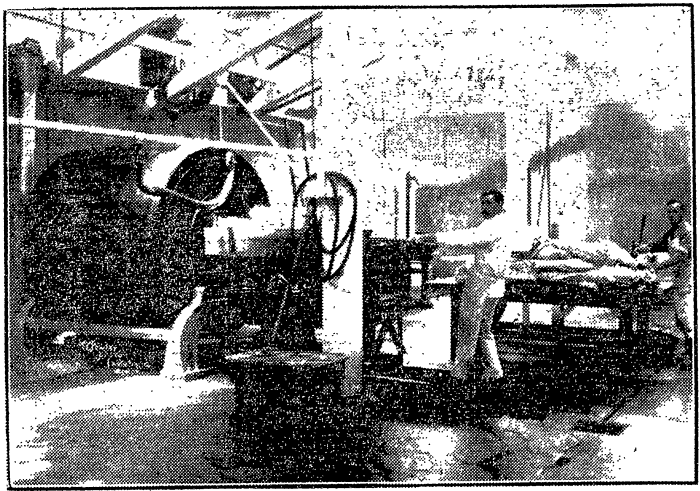Eleven years of steady progress
1905
In the year of 1905, the Company was authorised by an alterations of its
Articles of Association:
"To carry on the business of general store keepers. To act as agents
for the sales and purchase of - stock, produce, goods, motor vehicles-"
Thereupon began, very cautiously, the useful service of the trading
department, furnishing fertilisers, lime, separators, and a general line of farm
requisites.
The first transaction recorded was the sale on hire purchase of eight cows
to
Korani Pihuna - this was in 1914. At about the same date, five tons of
basic slag were purchased.
How this trading branch grew is illustrated by the purchase of 1000 tons
of
basic slag at £3 per ton by Chairman Fred Cullen in
the year 1930.
The Annual Report of the Jubilee year sets out
trading sales at £45,222. A commentary on the universal practice of
top-dressing arrived at in 1952 is the £12,947 total for fertiliser sales.
1906
In 1906 Messrs. J. B. McEwan & Co., leading
butter buyers and agents recommended abbreviation of the Company's brand to "Tutoroto,"
but local sentiment was too strong - for many more years, London auctioneers had
the embarrassment of trying to pronounce "Maungaturoto." At a later date the brand
became "Otamatea," which is, perhaps, a little better.
In the same year, Manager Campbell, representing
The North Kaipara Co-operative Dairy, waited on the Directors with an invitation
to agree on zones of supply and on equal payout. Agreement was not reached
and the anomaly of competition between co-operative companies continued.
1907
In 1907, the Company dealt with no less than
twenty two new applications for shares - the enterprise was growing.
Up to this date, factory butter was finished on
the open revolving table, a picturesque, but laborious operation which expelled
much moisture, making a product dry with about 12% of water.
A notable change was brought about jointly by
the past and present factory managers which became a boon to all dairy companies
in New Zealand.
In 1904, when exploring Canada, Manager Campbell
was intrigued with the combined churn and butter worker in general use. He
visited the makers, Richardson & Sons of St. Mary's Ontario, and induced
them to consign a couple to Messrs. J. B. McEwan & Coy. of Auckland.
No one had the courage to use
this innovation but the Directors and Manager Newitt of our Company - they found
it to be, like its name a complete "Success." Other companies completely
followed the lead thus given - bigger and stronger machines were manufactured in
Christchurch, and soon the merry-go-round table became a museum piece.
It is our pleasure to record
that once again the still small Maungaturoto company thus pioneered a major
advance in the dairy field. Not only was the buttermaker eased of a
backbreaking job, but the product made by the new method contained nearly all of
its natural moisture, sixteen per cent.
If one of our bright young
secretaries were to compute how much extra money accrued to the whole industry,
it would be an amazing total - all initiated by the enterprise of Maungaturoto.
Here it is appropriate to
remind the reader that the Company at an early date and as already set out,
pioneered the universal adoption of the home-separated cream system.
1907 - 1909
In 1907, the milking machine
began its labour saving service when Mr. Henry McMurdo installed a "Lawrence
Kennedy," steam driven, in view of the period unreliability of the internal
combustion engine, Mr. A. J. Grant, in the same year acquired a "Harnett."
In Maungaturoto, Messrs Judd
Brothers mechanised their milking with an "L.K.G." in the year 1908. Mr
Albert Curtis followed suit in 1912.
Mr Fred Cullen introduced the
first pedigree Jersey stock to the settlement in 1909.
The output of the season
1908-09 was sold to Bevins & Baker at a price of 11 ⅛ pence per pound.
This firm was forced into liquidation and the Company was faced with the
possibility of losing £1,100. Fortunately, realisations reduced the nett
loss to £200. Other companies in North Auckland lost out in the same way -
the fault lay with the loose financial methods prevailing at this date.
At this time the Settler's
Telephone System was giving service and on 17th October, 1911, the Company
purchased a telephone outfit which gave quick contact with its suppliers.
Now the railway bridge over the
river was under construction, but much tunnelling and formation had still to be
done before the Iron Horse reached the settlement station.
1912
Paspalum now began to be in
evidence. This vigorous Hungarian plant was first demonstrated by Mr.
Frank Pheasant of Matakohe who had a small field which looked like an oasis when
surrounding pastures were browned off in the dry months.
Neighbours started to grow it
in their gardens and dibble in small plants in the field. There was some
opposition and one of the leading settlers declared it "the worst weed yet to
appear in Maungaturoto."


